Snakes and lizards are spring and summer staples, and, in a way, they’re harbingers of spring. While you might see one on an unusually warm winter’s day, most stay hidden in dens to keep from freezing to death.
Most snakes and lizards are harmless bug and rodent eaters, but some can do real damage. For example, the summertime buzz of a rattlesnake’s tail makes most people’s skin crawl, especially if it’s near your home – with your pets and children. A bite from one can easily kill a small animal or child and send an adult to the hospital.
Clearly, they can’t keep slithering around all winter – rattlesnakes are cold-blooded and can’t handle the cold. So where do they go when winter arrives?
To answer this, we need to understand more about rattlesnakes and their biology.
What is a Rattlesnake?
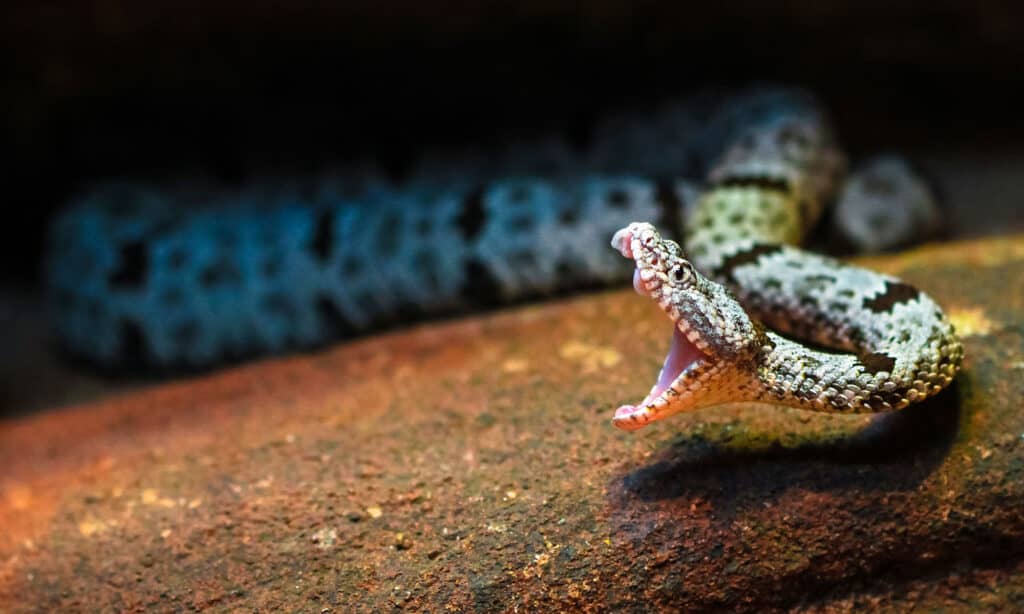
Rock rattlesnakes are one of the 60 species of rattlesnakes.
©Kevin Wells Photography/Shutterstock.com
A rattlesnake is a large-bodied pit viper in either the Crotalus or Sistrurus genus. It has large fangs that fold up into its mouth when they don’t need to bite something. These fangs are attached to large venom glands in their cheeks – giving it the trademark huge head.
These snakes go by a few names, and whether you call them rattlesnakes, buzz-tails, or rattlers, the primary identifying feature is the rattle at the end of their tails. However, not all rattlesnakes have rattles. Juveniles can’t rattle and only have a nub at the end of their tails.
There are over 60 rattlesnake species, ranging from the tiny massasaugas and pygmy rattlesnakes in the Sistrurus genus to the huge eastern diamondback rattlesnake in the genus Crotalus, where scientists classify most rattlesnakes.
Scientists suspect that the rattlesnake’s unique warning system evolved as a response to being trampled by the bison that once roamed most of North America. The big lumbering animals needed time to avoid the slithery pitvipers, and since many snakes already rattle their tails in leaves, a permanent rattle was the perfect answer to a rather large problem.
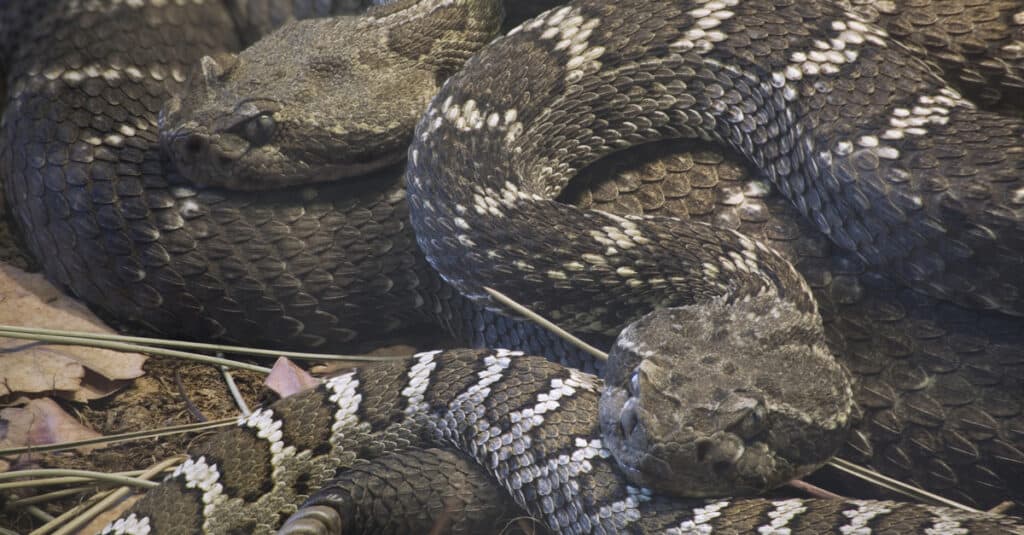
Arizona black rattlesnakes share communal dens and females may share parenting duties.
©Dario Sabljak/Shutterstock.com
Where Do Rattlesnakes Live?
Rattlesnakes are strictly New World snakes. They are only native to the Americas, so the only reason you’d see one somewhere else in the world is by accident, in someone’s private collection, or a zoo.
They inhabit areas of southern Canada south to northern Venezuela and most places in between. The deserts and open grassland with a scrub brush or rocky crevices to hide. Some prefer forested areas, like the timber rattlesnake or eastern diamondback rattlesnake. Regardless, wherever they live, they need hiding places.
Scientists believe that rattlesnakes evolved fairly recently in comparison to other snakes. The venom-delivery system is highly developed and specialized, and the pits are a more recent adaptation. It seems that the rattle came last.
Rattlesnakes are primarily nocturnal or crepuscular, so they aren’t typically visible during the day. Instead, they come out in the evenings and at night, if they come out at all. These snakes prefer to be out of sight and hidden from predators and prey. As ambush predators, they’re not going to look for food if waiting does the job.
Rattlesnake Physiology
Rattlesnakes are ectothermic, meaning they rely on external heat to maintain their body processes. All reptiles are ectothermic, but some are more cold-adapted than these notorious pit vipers.
Snakes regulate their body temperature by moving from warm to cold areas as needed. Digestion and other typical processes generate some heat by default. However, they can’t generate enough of their own body heat to support their digestion, so they depend on their environment.
Most encounters between people and rattlesnakes happen when outside temperatures are between 70 and 85º Fahrenheit. The snakes like these temperatures, and ironically, so do people. Rattlesnakes’ bodies digest food the most effectively at 80º-85ºF; according to a study of timber rattlesnakes (C. horridus), pit vipers can take anywhere from two to forty-one days to digest a meal.
When the external temperatures drop below 70ºF, the snakes begin to head for their winter dens.
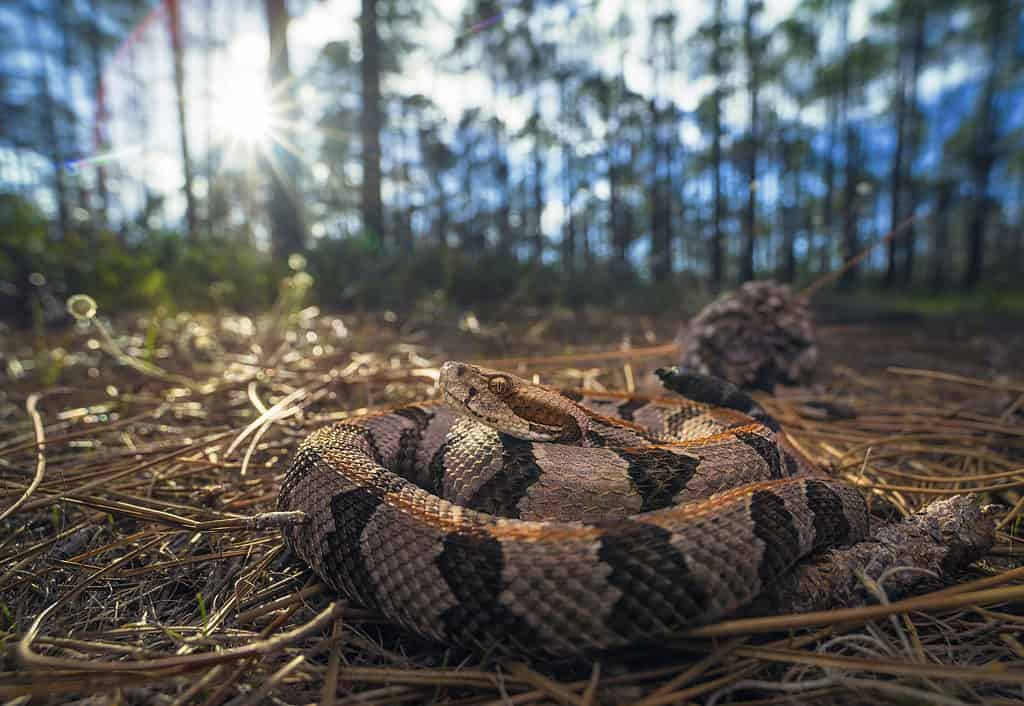
Most encounters between people and rattlesnakes happen when outside temperatures are between 70 and 85º Fahrenheit.
©Kristian Bell/Shutterstock.com
How Rattlesnakes Handle Cold Weather
Snakes, in general, don’t do much when it’s cold. Some cold-adapted species, such as the European adder (Vipera berus) and common garter snake (Thamnophis sirtalis), can live in colder-than-expected conditions. However, the cooler temperatures and shorter days accompanying fall trigger a rest cycle for most snakes.
Many snakes brumate alone, under a log, in an abandoned rodent burrow, or in a house. Once they’ve found a place they like, they often return to it one year after another. However, rattlesnakes are more social than people realize. Many rattlesnakes use communal dens, where sometimes thousands of snakes brumate together to maintain a little warmth through the cold winter. Some rattlesnakes, like timber rattlesnakes, have used the same communal den for generations.
While the rattlesnakes are in their dens, many species take the chance to breed. Rattlesnakes give birth to live babies that measure 6-12 inches long. When they’re born, the babies stay with their mothers for the first week to two weeks until their first shed. Rattlesnakes that use communal dens almost always return to the same den yearly.
There is even evidence of co-parenting between different females among the Arizona black rattlesnake (Crotalus cerberus) and timber rattlesnake (Crotalus horridus). In addition, females have been observed protecting one another’s young. Family groups usually stay closer together in dens and associate with one another in the spring. You could almost say they have friends.
What is Brumation, and Where Do Rattlesnakes Brumate?
Most rattlesnakes brumate for at least a little bit of the year, and the further north they live, the longer they have to brumate. However, it may stay warm enough all year in Central and South America that snakes don’t need to brumate.
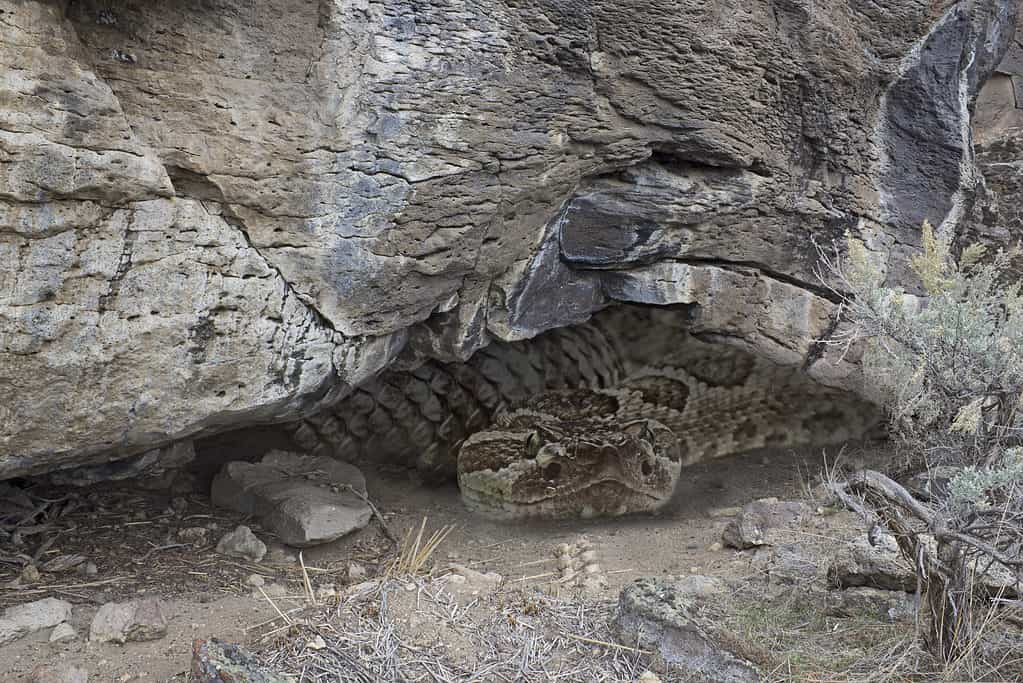
Most rattlesnakes brumate for at least a little bit of the year, and the further north they live, the longer they have to brumate.
©Ginger Livingston Sanders/Shutterstock.com
Brumation is the reptilian version of hibernation. However, whereas mammals sleep deeply and don’t need to eat or drink, snakes still have to drink and don’t sleep as deeply. In addition, mammals build fat stores during the summer, but reptiles focus on building glucose (sugar) stores in their body to weather the winter. Reptiles like snakes focus on building glucose up in the body, which is how some reptiles and amphibians can survive being frozen solid.
When a rattlesnake (or other reptiles) brumates, its body processes slow down to a crawl, it can’t eat because food would rot in its stomach and cause illness or death, and it can’t respond quickly to threats. That’s not to say they can’t inflict a dangerous bite during brumation – because they can. Instead, it just means that they may not be quite as inclined to bite unless you really upset or frighten them.
During the winter, rattlesnakes brumate in caves, burrows, or rocky crevices where they can be safe from predators. Most of these snakes prefer to use the same location every year, but in the end, they’re opportunistic and will do what they must to survive. This means that if your home has a great hiding spot like a log pile and access to the underside of your house or patio, they’ll use it. They must also be close enough to a water source and somewhere convenient to warm up their bodies. While a snake out on a warm winter day may surprise you, it’s not unusual. They’ll take advantage of a nice day to bask and get a drink of water before heading back into the den until early March or April.
Is it Normal for Rattlesnakes to Brumate?
Most rattlesnakes brumate for at least a little bit of the year, and the further north they live, the longer they have to brumate. However, it may stay warm enough all year in Central and South America that snakes don’t need to brumate.
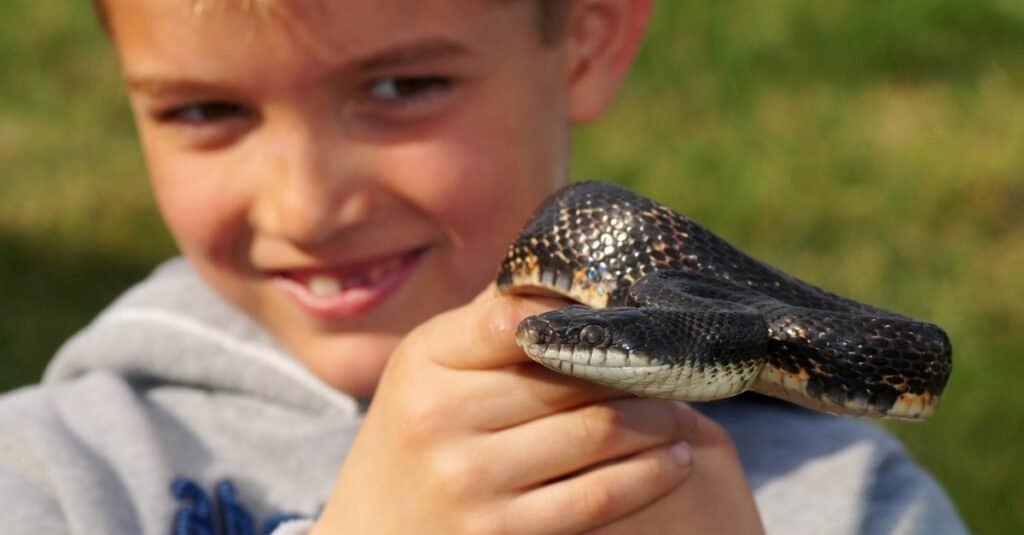
Despite your efforts to provide a perfect home – pet snakes often brumate.
©Matt Jeppson/Shutterstock.com
Do Pet Snakes Brumate?
Pet snakes may not have a reason to brumate – but it is a natural, innate thing for them to do. Even though they are living in a warm environment – they can’t resist the urge. Their biological clocks may take over and lure them into a winter’s rest. If your pet brumates it is a good idea to make sure they are healthy and parasite free before their big nap.
Where Do Rattlesnakes Go in the Rain?

Strong downpours can displace snakes out of their normal hiding spots.
©Brian A Jackson/Shutterstock.com
While it may sound like an odd question to ask, asking what happens to snakes in heavy rainfall is a good query to make sure you and your family do not end up running into a potentially dangerous snake.
For the most part, your average rainy situation is not going to negatively impact the local snake population, yet these slithering reptiles do like to make nests in dried out banks, in holes, in drainage systems, and other suitable hiding spots that can be over flooded. Heavy downpours or sudden flash floods can, however, alter snakes’ homes and send them looking for a nice dry spot to spend some time. This could very well be your home, shed, garage, or anywhere else that you might not be expecting. If you are in a part of the country that has venomous snakes (and you probably are!) it is best to be aware and careful of where you step and what you pick up after a surprise rainstorm.
The photo featured at the top of this post is © Alexander Wong/Shutterstock.com
Discover the "Monster" Snake 5X Bigger than an Anaconda
Every day A-Z Animals sends out some of the most incredible facts in the world from our free newsletter. Want to discover the 10 most beautiful snakes in the world, a "snake island" where you're never more than 3 feet from danger, or a "monster" snake 5X larger than an anaconda? Then sign up right now and you'll start receiving our daily newsletter absolutely free.
Sources
- Beaupre, S. J., & Zaidan, F. (2012). Digestive Performance in the Timber Rattlesnake (Crotalus horridus) with Reference to Temperature Dependence and Bioenergetic Cost of Growth. Journal of Herpetology, 46(4), 637–642. http://www.jstor.org/stable/23327186, Available here: https://www.jstor.org/stable/23327186
FAQs (Frequently Asked Questions)
What is a rattlesnake?
A rattlesnake is a large-bodied pit viper in either the Crotalus or Sistrurus genus. It has large fangs that fold up into its mouth when they don’t need to bite something. These fangs are attached to large venom glands in their cheeks – giving it the trademark huge head.
Where do rattlesnakes live?
Rattlesnakes are strictly New World snakes. They are only native to the Americas, so the only reason you’d see one somewhere else in the world is by accident, in someone’s private collection, or a zoo.
Thank you for reading! Have some feedback for us? Contact the AZ Animals editorial team.






